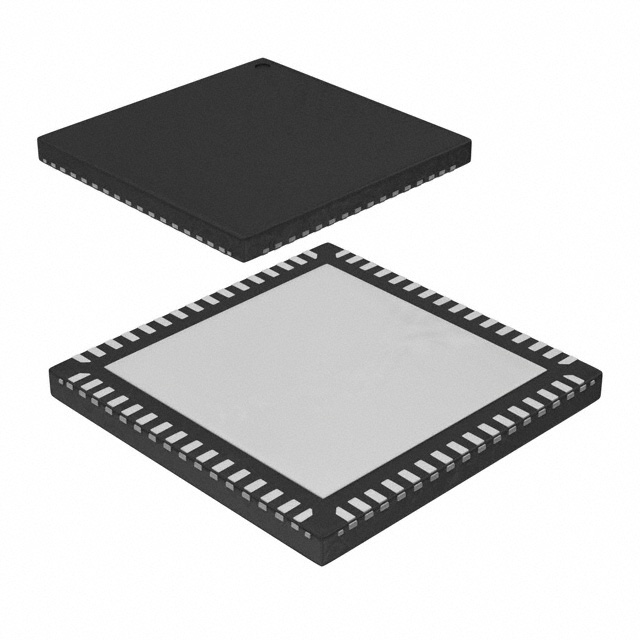Viz Specifikace pro podrobnosti o produktu.

AT91SAM7S256C-MU-999
Product Overview
Category
The AT91SAM7S256C-MU-999 belongs to the category of microcontrollers.
Use
This microcontroller is commonly used in various electronic devices and embedded systems.
Characteristics
- High-performance 32-bit ARM architecture
- Clock frequency up to 55 MHz
- Flash memory capacity of 256 KB
- SRAM capacity of 64 KB
- Low power consumption
- Multiple communication interfaces (UART, SPI, I2C)
- Analog-to-digital converter (ADC) with multiple channels
- Real-time clock (RTC) functionality
- Wide operating voltage range
Package
The AT91SAM7S256C-MU-999 is available in a compact surface-mount package.
Essence
This microcontroller combines high performance, low power consumption, and a wide range of features, making it suitable for a variety of applications.
Packaging/Quantity
The AT91SAM7S256C-MU-999 is typically packaged in reels or trays, with quantities varying based on customer requirements.
Specifications
- Architecture: ARM7TDMI-S
- Clock Frequency: Up to 55 MHz
- Flash Memory: 256 KB
- SRAM: 64 KB
- Operating Voltage: 1.65V to 3.6V
- Communication Interfaces: UART, SPI, I2C
- ADC Channels: Multiple
- Timers/Counters: Multiple
- GPIO Pins: 53
- Operating Temperature Range: -40°C to +85°C
Detailed Pin Configuration
The AT91SAM7S256C-MU-999 has a total of 100 pins. The pin configuration is as follows:
- Pin 1: VDDIO
- Pin 2: PA0
- Pin 3: PA1
- Pin 4: PA2
- ...
- Pin 99: GND
- Pin 100: VDDCORE
For a complete pin configuration diagram, please refer to the product datasheet.
Functional Features
1. High Performance
The AT91SAM7S256C-MU-999 is based on the ARM7TDMI-S architecture, providing high processing power and efficient execution of instructions.
2. Low Power Consumption
With its advanced power management features, this microcontroller minimizes energy consumption, making it suitable for battery-powered applications.
3. Versatile Communication Interfaces
The UART, SPI, and I2C interfaces enable seamless communication with other devices, expanding the connectivity options for various applications.
4. Rich Analog Capability
Equipped with an ADC supporting multiple channels, the AT91SAM7S256C-MU-999 can accurately convert analog signals into digital data, facilitating sensor integration.
5. Extensive Peripherals
The microcontroller offers a range of timers/counters and GPIO pins, allowing for flexible control and interfacing with external components.
Advantages and Disadvantages
Advantages
- High-performance ARM architecture
- Low power consumption
- Versatile communication interfaces
- Rich analog capability
- Extensive peripheral support
Disadvantages
- Limited flash memory capacity compared to some other microcontrollers in the same category
- Relatively higher cost compared to entry-level microcontrollers
Working Principles
The AT91SAM7S256C-MU-999 operates based on the ARM7TDMI-S architecture. It executes instructions stored in its flash memory, interacting with peripherals and external devices through various communication interfaces. The microcontroller's internal clock drives its operations, while its power management features optimize energy consumption.
Detailed Application Field Plans
The AT91SAM7S256C-MU-999 finds applications in various fields, including but not limited to: 1. Industrial automation 2. Consumer electronics 3. Automotive systems 4. Medical devices 5. Internet of Things (IoT) devices
In industrial automation, this microcontroller can be used for controlling machinery and monitoring processes. In consumer electronics, it can power smart home devices or portable gadgets. Automotive systems can benefit from its processing capabilities for engine control units and infotainment systems. Medical devices can utilize its analog-to-digital conversion features for accurate measurements. Lastly, in the IoT domain, the AT91SAM7S256C-MU-999 can enable connectivity and data processing in various applications.
Detailed and Complete Alternative Models
- ATmega328P: This microcontroller from Atmel offers similar features and is widely used in Arduino boards.
- STM32F103C8T6: A microcontroller from STMicroelectronics, providing a balance between performance and cost.
- PIC18F4550: Microchip's microcontroller with USB functionality, suitable for USB-based applications.
- LPC1768: NXP's ARM Cortex-M
Seznam 10 běžných otázek a odpovědí souvisejících s aplikací AT91SAM7S256C-MU-999 v technických řešeních
Sure! Here are 10 common questions and answers related to the application of AT91SAM7S256C-MU-999 in technical solutions:
Q: What is the AT91SAM7S256C-MU-999 microcontroller used for? A: The AT91SAM7S256C-MU-999 microcontroller is commonly used in various technical solutions, including industrial automation, robotics, embedded systems, and IoT applications.
Q: What is the maximum clock frequency supported by the AT91SAM7S256C-MU-999? A: The AT91SAM7S256C-MU-999 microcontroller supports a maximum clock frequency of 55 MHz.
Q: How much flash memory does the AT91SAM7S256C-MU-999 have? A: The AT91SAM7S256C-MU-999 microcontroller has 256 KB of flash memory for program storage.
Q: Can I expand the memory of the AT91SAM7S256C-MU-999? A: Yes, the AT91SAM7S256C-MU-999 supports external memory expansion through its external bus interface.
Q: What peripherals are available on the AT91SAM7S256C-MU-999? A: The AT91SAM7S256C-MU-999 microcontroller offers various peripherals, including UART, SPI, I2C, ADC, PWM, timers, and GPIO pins.
Q: Is the AT91SAM7S256C-MU-999 compatible with Arduino? A: No, the AT91SAM7S256C-MU-999 is not directly compatible with Arduino. However, it can be programmed using the ARM Cortex-M development tools and libraries.
Q: Can I use the AT91SAM7S256C-MU-999 for real-time applications? A: Yes, the AT91SAM7S256C-MU-999 microcontroller is suitable for real-time applications due to its fast clock speed and interrupt handling capabilities.
Q: What programming language can I use with the AT91SAM7S256C-MU-999? A: The AT91SAM7S256C-MU-999 can be programmed using C or C++ languages, utilizing the ARM Cortex-M development tools and compilers.
Q: Does the AT91SAM7S256C-MU-999 support low-power modes? A: Yes, the AT91SAM7S256C-MU-999 offers various low-power modes, including sleep, standby, and backup modes, to optimize power consumption in battery-powered applications.
Q: Are there any development boards available for the AT91SAM7S256C-MU-999? A: Yes, there are several development boards available that feature the AT91SAM7S256C-MU-999 microcontroller, providing a convenient platform for prototyping and testing technical solutions.
Please note that the specific part number "AT91SAM7S256C-MU-999" mentioned in the question may not correspond to an actual microcontroller variant. The answers provided are based on general knowledge of AT91SAM7S256C microcontrollers.

